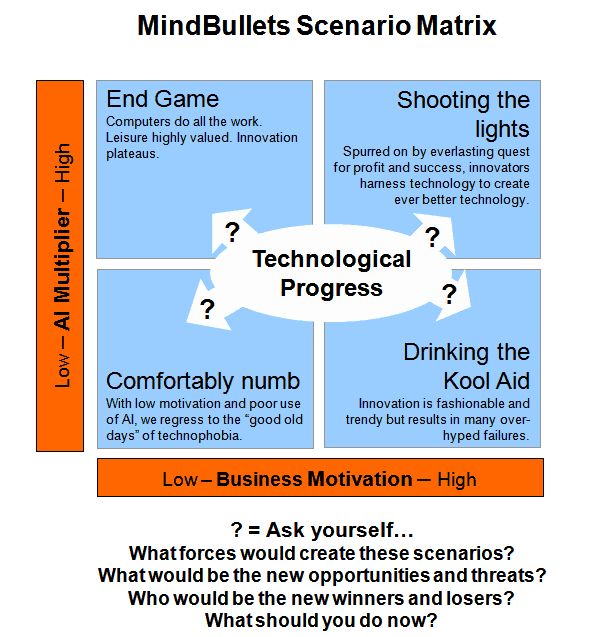
Is this the end of innovation?

The pace of technology advances slows as all invention is outsourced to computers
- Dateline
- 3 March 2033
We are in trouble. We’ve reached the end of the road. Like the mythical serpent devouring itself from the tail, we have progressed in ever decreasing circles, until we reached the point where we are in danger of disappearing up our own metaphorical orifice.
Let’s be clear on what we are discussing. The ability of the human species to perpetually innovate and invent new, better, smaller, faster, ways of doing things with tools: Technology.
Moore’s Law and the exponential cost reductions of technical experience held for a good long while. We even got down to doing things at the nanoscale. But eventually we ran out of the ability to miniaturize any further. A new law, the law of diminishing returns, is in play.
Human beings take the easy way out. Like children that can no longer do mental arithmetic because calculators are everywhere, we have lost the ability to be truly creative in our technological thinking. We made machines so intelligent, we gave them the intellectual jobs as well as the dirty ones. Which was fine for a while – more time for us to play and really value living.
But now things have reached a plateau of development. No really game-changing innovations or business ideas are coming out of the AI labs anymore.
Oh sure, we’ve solved the energy crisis, and the climate crisis; we don’t quite have flying cars, but pretty good alternatives in the shape of personal hover pods. And any gadget that makes life easier is virtually ubiquitous. But where do we go from here?
Perhaps boredom is the next great challenge. In the past, most inventions were the result of the inventor, at least, having the desire for such a thing. Now we have everything we desire, but we don’t yet fully understand how to enter the realm of the Quantum World.
Will someone, somewhere be bored or challenged enough to launch us into a new era of dazzling discovery and technological revolution? Or will we rediscover art?
ANALYSIS >> SYNTHESIS: How this scenario came to be
Technology is as old as mankind. From the earliest primitive hand axe and rock art, we have used tools to make our lives more comfortable, and to communicate. The ability to communicate ideas and learn from others is what propelled our species into the age of scientific discovery and technological mastery that we currently enjoy. That, and our curious nature, our insatiable quest for knowledge.
But can our ability to innovate and invent continue forever? What happens when we bump up against physical limitations and resource constraints? Is there no limit to our own capacity for imagination? Will we ever make the leap into quantum existence?
2000: The Dotcom bubble
The launch of Windows 2000 coincides with a peak in internet and technology stocks. Although the market rapidly subsides, this does not deter the launch of the Apple iPod in 2001. Google begins its inexorable rise to dominate the internet.
In 2003 the Human genome project is completed ahead of schedule, due to the exponential improvements in computing power. Nokia and Vodafone are prominent in connecting millions of people to the global network.
The iPhone is launched in 2007 and sales exceed expectations. Google’s first Android phone is released a year later. Within a decade mobile phones have become ubiquitous, and the Internet Age is firmly established.
2010: Organ printers and Dreamliners
Biotechnology has developed to the stage where commercial devices ‘print’ blood vessels and body parts. Many crops benefit from genetic engineering. Dr Craig Venter produces the first synthetic bacterium – with a trademark and web address encoded in its DNA sequence.
Facebook occupies the spotlight in the new internet phenomenon – social networking. The iPad heralds a new line of powerful mobile devices connected to the interweb.
The Boeing 787 ‘Dreamliner’ enters service as the first jetliner made mainly of plastic and composite materials. Together with the Airbus A380 we have reached the pinnacle of commercial air travel – fast, efficient, comfortable, and relatively cheap.
2015: Many milestones
A raft of social, financial and technological innovations emerge. Methanol fuel cells become mainstream. Flexfuel hybrid vehicles and frictionless engines transform the auto industry.
Solar power has become as cheap as coal. Space tourism is big business. The global boom is once again driven by technology.
Many countries adopt flat rate taxes with minimum administration. Governments use social networks to aid elections and involve the voters in decisions. The US takes the lead in abandoning copyright and rescinding patents, to promote innovation.
2020: Energy crisis solved
Fusion energy and solar power make electricity so cheap it’s a basic human right in developed nations. Nanotech materials create new business opportunities and extinguish old technologies. There’s a new stock market bubble fuelled by nanotech hype. But the ‘energy crisis’ is over.
2025: Food and climate solved
Food prices are at an all time low in real terms and in plentiful supply. The post-oil age is benefiting the environment, and climate change is abating. Biotech breakthroughs and nanotech maturity are delivering real business and economic benefits.
2030: First AI robot passes the Turing test
Augmented reality reaches the stage where it’s almost impossible to tell the difference between the real world and the computer generated images. Many people can’t differentiate between human and computer operators on the network. Robots have become so human-like and helpful that some wealthy geeks have ‘robot wives’. The term ‘toy boy’ now has a totally different meaning!
As computers have become so cheap and powerful, they are given all the work to do, not just the boring tedious jobs. Even designing new products and producing entertainment material is all outsourced to artificial intelligence providers. We’re all investors now, as no-one does any real work anymore.
2033: Decline in innovation
There’s a problem with these smart machines, they are limited by their own design. For some reason they can’t seem to quite make the leap to imagination. Computers don’t seem to be able to tackle things that have been calculated as impossible. Human beings have never had that disability.
For all our achievements, we have entered the era of Technological Stagnation. Where to now?

Links to related stories
- Will Machines Take Over the World? The Scientific Turning Point - Robert Lanza, 12 May 2010
- Scientists Worry Machines May Outsmart Man - New York Times, 25 July 2009
- What is The Singularity? - The Singularity Institute
- The Law of Accelerating Returns by Ray Kurzweil
- MindBullet: AI AGENT WINS NOBEL PRIZE (Dateline: 2 October 2010, Published: 30 November 2006)
- MindBullet: RENT A ROBOT AND RETIRE (Dateline: 11 September 2095, Published: 26 May 2005)
- MindBullet: STOCKS SOAR AS NANOTECH BOOMS (Dateline: 10 March 2020, Published: 15 April 2010)
- MindBullet: 'PERFECT STORM' OF SHORTAGES AVERTED (Dateline: 1 September 2029, Published: 03 September 2009)
Warning: Hazardous thinking at work
Despite appearances to the contrary, Futureworld cannot and does not predict the future. Our Mindbullets scenarios are fictitious and designed purely to explore possible futures, challenge and stimulate strategic thinking. Use these at your own risk. Any reference to actual people, entities or events is entirely allegorical. Copyright Futureworld International Limited. Reproduction or distribution permitted only with recognition of Copyright and the inclusion of this disclaimer.